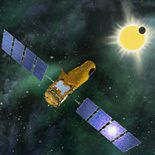-
 Creutzfeldt-Jakob Disease
Creutzfeldt-Jakob Disease
-
 Pumice
Pumice
-
 Granivore
Granivore
-
 Planetary aberration
Planetary aberration
-
 Infusion
Infusion
-
 Clinical history
Clinical history
-
 Variability in heart rate
Variability in heart rate
-
 Uterus
Uterus
-
 Fuel cell
Fuel cell
-
 GPRS
GPRS
-
 Acaulescent
Acaulescent
-
 Ocytocin
Ocytocin
-
 Cerumen
Cerumen
-
 Dormant
Dormant
-
 Glomerulonephritis
Glomerulonephritis
-
 Measles virus
Measles virus
-
 Special relativity
Special relativity
-
 Nasal polyp
Nasal polyp
-
 Optoelectronics
Optoelectronics
-
 Steppe
Steppe
-
 Direct thrombin inhibitor
Direct thrombin inhibitor
-
 Hemicrpytophyte
Hemicrpytophyte
-
 Atherogenic
Atherogenic
-
 Colorectal
Colorectal
-
 Conflict
Conflict
-
 Mars Odyssey
Mars Odyssey
-
 Google Bombing
Google Bombing
-
 Sensor
Sensor
-
 Geomembrane
Geomembrane
-
 Eclipse
Eclipse
Corot
The CoRoT space observatory (COnvection, ROtation & Transits planétaires), initiated by the CNES and implemented in partnership with the CNRS, the ESA, Austria, Belgium, Germany, Spain and Brazil, has a 27 cm afocal telescope and a wide field camera with four ultra-sensitive CCD detectors on board. Its mission: to study the internal structure of the stars in order to deduce their mass, their age and their composition, and to search for extra-solar planets around nearby stars.
Operation
CoRoT was launched on Wednesday 27 December 2006 at 14h23 UT by a Soyuz 2.1b rocket from the Baikonur cosmodrome and put into a circular polar orbit at 896 km inclined at 90°, an ideal situation from which it can continuously scrutinise any point in the sky for 150 days without the least interruption, and without being occulted by the mass of our planet.
Scientific questions
Corot's telescope is planned to successively observe five different parts of the sky thereby collecting a large number of measurements on the structures of thousands of stars. All this data will be extremely valuable because it will give direct access to the chemical elements making up the universe (which form in the stars).
CoRoT is also to carry out extremely high precision and long duration photometric measurements of stars likely to be orbited by planets. These can be detected by measuring the recorded photometric reading that will show the low variation in brightness caused by the passage of the planetary disk in front of its star.
If Corot discovers other planets many possibilities of inhabitable celestial bodies will be opened up. It could well be that bodies similar to the Earth could exist in other systems. By observing these other systems, scientists hope to improve their knowledge of the formation of our own solar system.
This stakes of this mission are both fundamental and twofold: detecting possible life forms and advancing the quest for our origins.

Corot
Latest
Fill out my online form.



